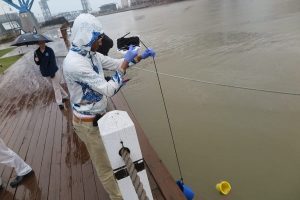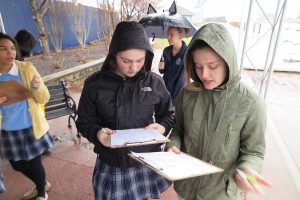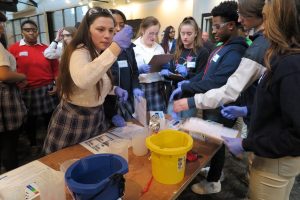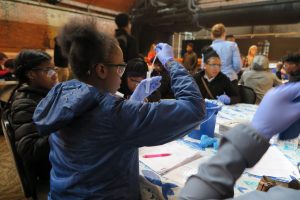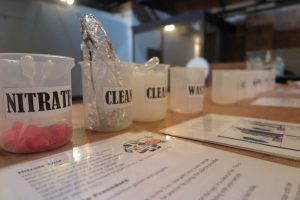Shark Spotlight: Sandtiger Sharks
It’s that time of year again—Fin Fest! Sharks are already on our minds 24/7, but this week-long celebration of sharks (July 22 – 29, 2018) gives us an excuse to really show how much we appreciate these jaw-some animals.
Of the three shark species in the Shark Gallery, sandtiger sharks are often the first ones you notice and the ones you remember long after you visit for a number of reasons. They tend to cruise around near the water’s surface, positioning themselves above the nurse and sandbar sharks at the top of the gallery’s vertical hierarchy. The aesthetics, too, are enough to drop a few jaws. Row upon row of ragged, razor-sharp teeth reveal themselves even while the shark’s mouth is at rest, lending an aggressive edge to an already imposing body that can grow to 10½ feet and more than 350 pounds.
However, the voracious behavior implied by these fearsome features couldn’t be further from the truth. In fact, sandtiger sharks are a very docile species known to attack humans only when bothered first. They’d much rather spend their time swimming at depths of about 60 to 100 feet, coasting around obstacles and looking for their next meal of small fish, crustaceans or squid. “You’ll find them around a lot of shipwrecks on the Carolina coast,” says aquarist Ray Popik. “They hang out around the top of the wreck … they don’t like to get down low and navigate between things.”
The sandtiger’s docility, though, develops only after it’s born. The pre-birth behavior of the species is just about the most brutal example of natural selection in the entire ocean. Along with several other shark species, the sandtiger has been known to practice intrauterine cannibalism — during pregnancy, the first pup to hatch uses the other eggs and embryos in the mother’s uterus as a food source. “The first egg that hatches wins,” says Popik. “It’s a pretty gnarly process, but in the end it allows them to provide the most amount of nutrition to put out the largest, most well-developed shark possible as a newborn.”
The sandtiger shark is also the only shark species that exhibits a certain hunting behavior: They are known to swim to the surface and gulp air into their stomachs, giving their bodies more buoyancy. This enables them to hover in the water with ease and stalk their prey by remaining completely motionless until the right time to strike. So, while they may not be the most aggressive swimmers or the most ravenous eaters, but when the time comes to feed they can put all those teeth to good use.
It doesn’t take long to find a sandtiger shark on a typical visit to the Aquarium. Their awe-inspiring stature and protruding rows of teeth catch the eyes of guests almost immediately as they enter the shark gallery. Popik agrees that their appearance combined with their behavior gives them an air of quiet dignity. “They have a presence in the exhibit,” he says. “The way they just cruise around; you can tell nothing bothers them.” Indeed, simply watching a sandtiger glide by or even overhead in the sea tube inspires a sense of respect for ocean life few other creatures can match.








